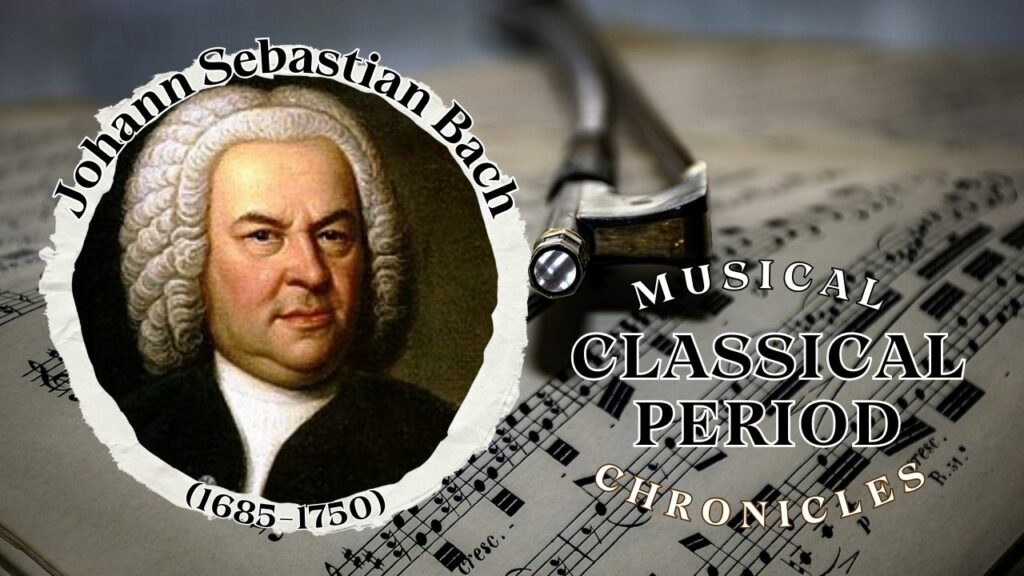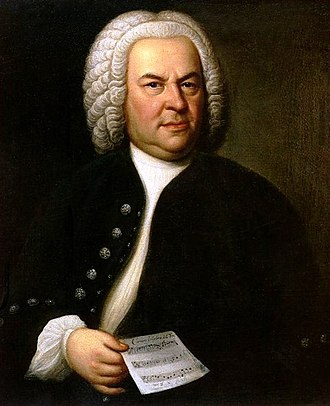
Johann Sebastian Bach (1685-1750)
The Prelude of Bach’s Overture
In the heart of 17th-century Germany, in the quaint town of Eisenach, a prodigious force was awakening—a force that would shape the very essence of classical music. Johann Sebastian Bach, a name whispered in reverence among musicians, embarked on a journey that would transcend the temporal constraints of his era.
The prelude to Bach’s episode unveils a canvas painted with the hues of Baroque intricacy. As we delve into the life of this musical luminary, we encounter a protagonist fueled not only by an intrinsic passion for composition but also by a steadfast dedication to his craft. Bach’s journey begins not in grand concert halls but in the intimate surroundings of family, faith, and the cultural happenstance of his time.
Our narrative takes an unexpected turn, introducing the audiences to Bach’s early years—a period where his virtuosity as an organist and a composer first started to bloom. It is within the walls of the churches and courts of Weimar, Arnstadt, and Mühlhausen that Bach’s harmonies found resonance, laying the foundation for a musical odyssey that would span generations.
The beginnings of Bach’s experiences, much like the intricate fugues he composed, captures the essence of an artist whose life was a perpetual pursuit of perfection. The audience finds itself captivated by the allure of the Baroque era, where ornate melodies and structured forms created a musical landscape that mirrored the societal nuances of Bach’s time.
This serves as an introduction to Bach’s narrative but also as a portal, inviting the audience to step into the corridors of history where a maestro crafted compositions that transcended the limits of imagination. The tantalizing prospect of unraveling Bach’s story beckons, promising an exploration of the man behind the scores—the complexities, the triumphs, and the enduring legacy that continues to resonate in the symphony of classical music.
A Symphony of Beginnings

Johann Sebastian Bach’s journey unfurls against the backdrop of Eisenach, Germany, a town immersed in the cultural tapestry of the Baroque period. Born into a family of musicians, young Johann’s initiation into the world of melody and rhythm began with the gentle guidance of his father, Johann Ambrosius Bach. In the midst of such artistic abundance, a prodigious talent was nurtured, laying the foundation for a musical legacy that would transcend generations.
Bach’s early years were characterized by the nurturing embrace of the church. As an orphan by the age of ten, he moved to Ohrdruf to live with his elder brother, Johann Christoph Bach. It was here, within the cloistered walls of the St. Michael’s School, that Bach’s musical prowess flourished. His exposure to the works of esteemed composers, coupled with an insatiable curiosity, set the stage for his future endeavors.
The young virtuoso’s voracious appetite for learning led him to embrace the diverse currents of Baroque music. The influences of Italian, French, and German compositions amalgamated within him, forming a rich reservoir of inspiration. Bach’s years in Arnstadt and Mühlhausen saw him taking the first steps as an organist and composer, crafting compositions that hinted at the unparalleled brilliance yet to come.
Around the harmonies of the Baroque era, Bach’s artistry evolved. His marriage to Maria Barbara Bach marked a significant juncture, intertwining personal joy with artistic fervor. Bach’s roles as a family man, court musician, and church organist converged, setting the stage for the unfolding saga of a genius in the making.
As the cultural and religious tapestry of Germany continued to weave its influence, Bach found himself drawn into the service of the Duke of Weimar. The courtly settings provided a fertile ground for his compositions, and it was during this period that he conceived some of his masterpieces, including the Brandenburg Concertos.
The beginning of Bach’s odyssey beckons the audience to witness the nascent sparks of genius. It is a journey not only through the corridors of history but also through the intimate spaces of family, faith, and artistic exploration. The audience is transported to an era where the foundations of classical music were laid, and a maestro began his ascent toward immortality.
Bach Interrupted
We interrupt this harmonious journey for a news bulletin that ripples through the Baroque air.
In a town square not far from Leipzig, where Bach had now firmly entrenched himself, a flurry of whispers stirred the cobblestone streets. News spread like wildfire—war had erupted on the European continent. The specter of conflict loomed over the serene landscapes that had cradled Bach’s musical pursuits.
As the political currents shifted, the peaceful existence of Leipzig faced turbulent times. Reports spoke of battles on distant frontiers, leaving the townsfolk on edge. The soothing melodies of Bach’s compositions, once a respite from the strains of life, now faced the dissonance of an uncertain era.
The interruption unfolded against the backdrop of soldiers marching through the town, a stark contrast to the notes that once echoed in Leipzig’s streets. The news bulletin carried the weight of reality, disrupting the idyllic scenes that had adorned the daily lives of its inhabitants. Notwithstanding the unsettling news, Bach’s compositions resonated as a balm—a reminder of the enduring power of art in the face of tumultuous times.
The echoes of war remain distant, but the impact reverberates through the cultural tapestry, casting shadows that even the luminous brilliance of Bach’s creations cannot entirely dispel. is interruption serves as a poignant reminder that, despite the transcendent nature of Bach’s work, the world around him remains subject to the discordant strains of history.
Now, back to our regularly scheduled program as we navigate the intricate counterpoint of Bach’s life and music.
Harmonies Resurrected: Leipzig’s Ode to Bach
In the heart of Leipzig, where the air still hung heavy with the echoes of war, Bach continued his tireless pursuit of musical perfection. The town had weathered the storm, but the scars of conflict lingered, casting a solemn hue over the cobblestone streets.
As Bach returned to the sanctuary of his composing room, the melodies he crafted became a testament to resilience. The intricate design of his compositions wove together the threads of hope and despair, mirroring the intricate dance of life in post-war Leipzig.
Surrounded by the chaos of reconstruction, Bach found solace in the timeless beauty of his creations. The citizens, too, sought refuge in the harmonies that resonated through the town square. The organ’s majestic notes, the delicate dance of strings, and the resonant hum of the harpsichord became the soundtrack of renewal.
In the evenings, Leipzig’s residents gathered in small enclaves to share in the communal experience of Bach’s music. It became a ritual—a collective acknowledgment that even in the face of adversity, the human spirit could find expression in the sublime cadences of art.
Thus was illuminated the transformative power of Bach’s compositions. As the town rebuilt its foundations, the music served as a guiding force, leading the community towards a renewed sense of purpose. The cacaphony of sound painted by Bach’s hand became a symbol of Leipzig’s resilience, a musical testament to the indomitable spirit of its people.
The music, once an escape, now became a beacon, guiding the town towards a future where the echoes of war would eventually fade into the harmonious rhythms of everyday life.
“Now, as we immerse ourselves once more in the symphonic journey of Johann Sebastian Bach, we find a town and its people embracing the transformative power of music.”
With the interruption behind them, the citizens of Leipzig ventured into a new chapter, carried forward by the timeless melodies that emanated from Bach’s prolific genius. The recurring segment served not only as a return to the narrative but as a celebration of resilience—a resounding affirmation that, even enveloped in discord, the human spirit could find harmony in the language of music.
In this episode, we explore how Bach’s compositions became a guiding force for Leipzig’s post-war revival, demonstrating that even in the darkest moments, the transformative power of music could breathe life into a community yearning for renewal.
Leipzig’s Musical Rebirth
As the final notes of Bach’s compositions resonated through the streets of Leipzig, the town found itself reborn. The echoes of war had transformed into harmonies of hope, and the citizens, once divided by strife, now stood united by the universal language of music.
In the end, the narrative shifted towards the horizon of new beginnings. Leipzig, having weathered the storms of conflict, emerged stronger, fortified by the melodies that had become the town’s heartbeat. The artistic tapestry woven by Bach had not only healed wounds but had also set the stage for the next chapter in the town’s musical journey.
As the citizens reveled in the resurgence of their cultural identity, a sense of anticipation hung in the air. The departure from war’s shadows paved the way for an era of enlightenment, and the transformative power of music had played a pivotal role in this metamorphosis.
Leipzig, now a testament to the symbiotic relationship between resilience and art, bid farewell to the echoes of war. In the distance, another musical luminary awaited his turn on the stage. The resolution concluded with a tantalizing glimpse into the future—a future shaped by the melodies of Franz Joseph Haydn.
With the promise of new harmonies on the horizon, the departure episode set the stage for the next installment in the chronicles of musical evolution. As Leipzig embraced the dawn of a new era, the audience was left with a sense of wonder, eager to explore the untold stories that lay hidden within the corridors of time.
“Now, as we transition from the resounding compositions of Johann Sebastian Bach, we turn our gaze towards the forthcoming melodies that will grace our ears. Join us as we embark on a new chapter, guided by the symphonic brilliance of Franz Joseph Haydn.”
This has not only served as a reflection on Leipzig’s journey but also as a prologue to the musical tapestry that continues to unfurl. The tantalizing promise of Haydn’s symphonies beckons, and the audience, having witnessed the transformative power of music, eagerly await the next chapter in this enchanting saga.
Return to the Classical Period Chronicles home page.
